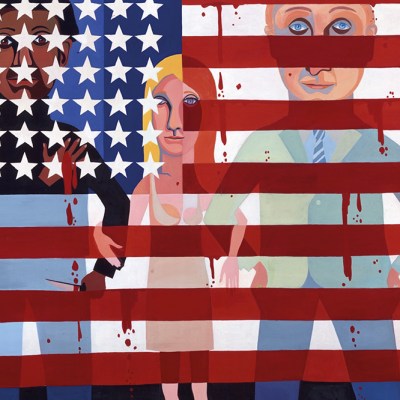Faith Ringgold
When the Museum of Modern Art in New York reinstalled its collection in 2019, amid widespread critical acclaim for the institution’s revisionist canon, one pairing in particular hit the headlines: Faith Ringgold’s American People Series #20: Die (1967) hanging next to Pablo Picasso’s Les Demoiselles d’Avignon (1907).
The juxtaposition was a radical one, not least because it was undeniable that this painting – acquired by the museum as recently as 2016, directly from the artist – could go toe-to-toe with one of the institution’s most prestigious works of art. It crowned Ringgold, now 92 years old, as a modern master. There were other inferences to be drawn from the comparison, among them the formal inheritances of Ringgold – an African American artist trained in the white European modernist tradition – but also her refusal of Picasso’s misogyny and colonialism. ‘MoMA traditionalists will call the pairing sacrilegious; I call it a stroke of curatorial genius,’ Holland Cotter wrote in the New York Times.
American People Series #20: Die (1967), Faith Ringgold. Museum of Modern Art, New York. © Faith Ringgold

Die, as it is known, is a graphic painting of violence, showing men, women and children, both Black and white, in a blood-spattered brawl. It is impossible to tell who is fighting whom, but it is clear nobody is winning. At its centre, a white, blond-haired boy clings, terrified, to an equally traumatised Black girl.
In February 2022 the painting was shipped across town to the New Museum, where it anchored ‘Faith Ringgold: American People’, a retrospective that celebrated the full breadth and depth of Ringgold’s lifetime achievement. In the second half of the year, the triumphant exhibition travelled to the de Young Museum in San Francisco.
Die made its debut in Ringgold’s very first solo exhibition, at the Spectrum Gallery in New York. She was 37 years old and had completed the work, along with two other large paintings from the same series, while her daughters were in Europe for the summer. The American People Series began in 1963 and initially featured boldly painted, superficially placid but uneasy groupings of white and Black figures. As racial tensions in the United States grew over the decade, so Ringgold found her uncompromising voice. She described herself as a ‘political reporter in terms of art’ and referred to her largest paintings, such as Die – influenced by Picasso’s panoramic Guernica (1937) – as ‘murals’.
In the years after her first exhibition, Ringgold became increasingly involved in activism. She protested, often with her two daughters, against the failure of museums such as the Whitney and MoMA to represent women artists – especially Black women artists – fairly in their exhibitions and collections. Ringgold organised, pamphleteered and agitated. In 1970 she was even arrested and convicted, along with two others, for curating an exhibition of artworks that ‘desecrated’ the US flag.
The formal and conceptual development of Ringgold’s art in this period was inseparable from her activism. Her style became flatter and bolder. Several paintings from her Black Light Series (1967–69) feature only text, segueing seamlessly into a subsequent series of political posters, which disregard the traditional hierarchical distinctions between agitprop and fine art.
Throughout her career, Ringgold has seen herself as a teacher – in elementary public schools as well as universities – as well as a mother, a daughter, an activist and an organiser. Her illustrated children’s books, including the well-loved Tar Beach (1991), broadened her audience. In the early 1970s she began to collaborate with her mother, Willi Posey, a gifted fashion designer and seamstress, on fabric wall hangings based on Buddhist thangkas. Her first works in this manner, The Feminist Series (1972–73), consisted of painted arboreal landscapes hemmed with patterned fabric borders. Transcribed vertically on to the calm paintings are incendiary quotes from Black trailblazers including Harriet Tubman and Sojourner Truth.
Ringgold and her mother made soft sculptures of life-sized masked figures, and even produced a line of racially distinctive dolls, marketed commercially for children. The Feminist Series led Ringgold to the story quilts, begun in 1983, which for many years were her best-known works. These complex pieces, which include panels of handwritten text alongside illustrations and patterned borders, interweave Ringgold’s biography with historical events, both real and imagined. In Picasso’s Studio: The French Collection Part 1, #7 (1991), a shirtless Picasso is shown painting a nude Black woman, a fictional character called Willia Marie, based on Ringgold herself and her mother. In the background is Les Demoiselles d’Avignon, the very painting Ringgold would one day confront at MoMA.
Ringgold has never ceased to transcend boundaries and divisions, social and artistic. ‘If she had been working in the South, Ringgold would have been labelled an “outsider artist”,’ wrote her friend Lucy Lippard, ‘but she is in fact a consummate insider to New York’s activist, feminist, and, finally, mainstream art worlds.’ Her life’s work has been to infiltrate art history, to call out the inequities of the present and create possibilities for so many others in the future.
When told of her Apollo Award, Ringgold was keen to share the accolade. ‘I am grateful for the recognition and also for all the people who have helped me along the way. No one can do it alone. From the beginning I have wanted to tell my story – or, more to the point, my side of the story. I wanted to inspire others and be inspired.’
Faith Ringgold (b. 1930) photographed in Miami in 2011. Photo: Rabbani and Solimene Photography/Stringer/Getty Images

Jonathan Griffin is a freelance writer in Los Angeles.




